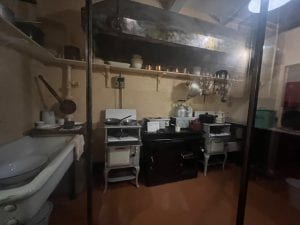By Cecelia Minard
The sites we visited while in the United Kingdom shared a common theme of solidarity and sacrifice. We had discussed the Brits’ sacrifices during the Second World War in our class on “Bombing the People,” but seeing these displays brought it to life. While the US Americans back home were peripherally affected by the war, the British were more directly affected, dealing with intense nights of German Luftwaffe bombings, known as the Blitz. The artifacts and historical records displayed at Bletchley Park, the Imperial War Museum, and the Churchill War Rooms demonstrated the British collective experience during the war. The British had to come together to survive.
During the Blitz, Londoners frequently hid in the underground railway system- known as the Tube- for protection. Government-issued Anderson shelters came in kits of six sheets of corrugated iron or steel to be constructed as bomb shelters in citizens’ backyards. Both the US and the UK rationed food but it was more severe in the UK than in the US, with sugar and meats being especially scarce. English families were even encouraged to send their kids to the countryside to protect them from the bombing raids. Nearly everyone participated in the war effort, leading the British to call the Second World War the “People’s War.”
I saw this highlighted consistently. The Imperial War Museum included a reconstruction of a standard house as it would have been in London during the war. Complete with a dining room table that doubled as a bomb shelter, gas masks, examples of rationed meals, and even a full-sized Anderson shelter in the back.
The Churchill War Rooms also demonstrated the British collective memory of the war, though in a different way than the Imperial War Museum. While the latter focused on the citizen’s common experience, the Churchill War Rooms focused on politics. Yet to me, the most interesting part of the War Rooms museum focused on civilian life, specifically the women that worked there. There was one chef for the War Rooms, a woman who felt her contribution to the war was feeding the decision-makers.
Another woman working in the War Rooms was Churchill’s secretary. Churchill’s brashness startled her at first, but she later got used to his direct communication style and was quoted saying she enjoyed working for him. She was kept busy almost constantly, writing down anything Churchill needed. These are a few examples of how British women contributed to the war effort.



